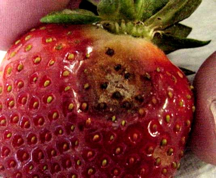- There have been no new reports of Late blight this this past week. All abandoned tomato fields should be mowed down or burned down with herbicide once harvesting is done.
- Pepper anthracnose remains active. Weekly maintenance sprays should continue as long as harvesting continues in fields where anthracnose is active.
- Following the heavy rains and with more rain expected over the weekend, bacterial leaf spot in pepper and marginal necrosis and leaf spot in leafy greens are being reported. Fungal leaf spots are also being reported. Preventative fungicide programs will help reduce fungal and bacterial problems in leafy greens.
- Cucurbit downy mildew has been confirmed on cucumber in New Jersey. Downy mildew is beginning to be reported on many other cucurbits in other parts of the country. All cucumber growers should continue with a downy mildew-specific fungicide to their weekly fungicide programs. All cucurbit growers need to scout on a regular basis and should mow or burn off fields when harvesting in done.
Search Results for: pepper anthracnose'
Vegetable Disease Briefs – 10/6/16
Vegetable Disease Briefs – 9/13/16
- Cucurbit downy mildew has been confirmed on cucumber in New Jersey. To date, cucurbit downy mildew has been reported on cucumber and melon in the mid-Atlantic region. Downy mildew is beginning to be reported on many other cucurbits in other parts of the country. All cucumber growers need to add a downy mildew-specific fungicide to their weekly fungicide programs. All cucurbit growers need to scout on a regular basis.
- Pepper anthracnose is being reported in southern New Jersey.
- Cucurbit powdery mildew is active on all cucurbit crops.
- There have been no new reports of Late blight this this past week.
Vegetable Disease Briefs – 9/6/16
- Cucurbit downy mildew has been confirmed on cucumber in New Jersey. To date, cucurbit downy mildew has been reported on cucumber and melon in the mid-Atlantic region. All cucumber growers need to add a downy mildew-specific fungicide to their weekly fungicide programs. All cucurbit growers need to scout on a regular basis.
- Dickeya dianthicola was confirmed in New Jersey on ‘Dark Red Chieftain’ originating from New Brunswick, Canada this past week. This is the third report of Dickeya on seed originating from Canada this summer. ‘Yukon Gold’ and ‘Reba’ from New Brunswick, Canada have also tested positive. In total, Dickeya dianthicola has been confirmed in 16 states to date. All potato growers are encouraged to scout fields and report any suspect plants/tubers. The best method for keeping your potato operation Dickeya-free is to adopt your own 0% Dickeya-tolerance policy.
- Pepper anthracnose is being reported in southern New Jersey.
- Cucurbit powdery mildew is active on all cucurbit crops.
- There have been no new reports of Late blight this this past week.
Vegetable Disease Briefs – 8/25/16
- Cucurbit downy mildew has been confirmed on cucumber in New Jersey. To date, cucurbit downy mildew has been reported on cucumber and melon in the mid-Atlantic region. All cucumber growers need to add a downy mildew-specific fungicide to their weekly fungicide programs. All cucurbit growers need to scout on a regular basis.
- Dickeya dianthicola has been confirmed in 16 states to date. All potato growers are encouraged to scout fields and report any suspect plants/tubers. The best method for keeping your potato operation Dickeya-free is to adopt your own 0% Dickeya-tolerance policy.
- Pepper anthracnose is being reported in southern New Jersey.
- Cucurbit powdery mildew is active on all cucurbit crops.
- Late blight was reported on tomato near Blacksburg, Virginia this past week.
Vegetable Disease Briefs – 8/15/16
- Cucurbit downy mildew has been confirmed on cucumber in New Jersey. To date, cucurbit downy mildew has been reported on cucumber and melon in the mid-Atlantic region. All cucumber growers need to add a downy mildew-specific fungicide to their weekly fungicide programs. All cucurbit growers need to scout on a regular basis.
- There have been no new reports of Late blight in tomato or potato.
- Dickeya dianthicola has been confirmed in 12 states to date. All potato growers are encouraged to scout fields and report any suspect plants/tubers. The best method for keeping your potato operation Dickeya-free is to adopt your own 0% Dickeya-tolerance policy. Click here for the latest Dickeya update.
- Pepper anthracnose is being reported in southern New Jersey.
- Cucurbit powdery mildew is active on all cucurbit crops.
Wet Weather Ripe for Strawberry Fruit Rots

Anthracnose Fruit Rot of Strawberry
Fruit rots in strawberry can cause significant losses if not recognized early and controlled. The use of good cultural practices such as: keeping fields weed-free and promoting good drainage; long crop rotations, and preventative fungicide applications are critical.
Pathogens such as anthracnose, gray mold (Botrytis), and leather rot can become systemic problems in strawberry plantings once established. All three fungal diseases are soil-borne and once in fields can be difficult to manage over the lifetime of the planting.
For growers new to strawberry production and/or those just looking for valuable resource(s), please visit Cornell University’s strawberry production website here. An Organic Strawberry Production Guide is also available.
The use of mulch (matted rows) to prevent/reduce soil splashing and keeping fruit from coming into direct contact with the soil surface can be beneficial in organic production systems where conventional fungicides cannot be used. Use of long crop rotations and staying away from areas of the farm with known instances of any of these pathogens is also important. Remember that same species of Colletotrichum that causes fruit rot in pepper and other crops can also infect strawberry.
